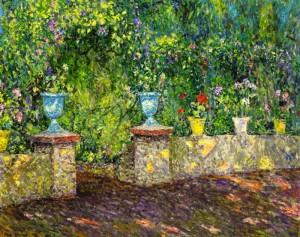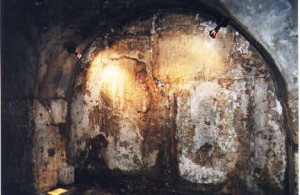When Up is Down (Part 8)
By Asher Crispe: June 10, 2014: Category Inspirations, Thought Figures
Kabbalistic Reflections on T.S. Eliot’s Four Quartets
Footfalls echo in the memory
Down the passage which we did not take
Towards the door never opened
Into the rose-garden.
T.S. Eliot Burnt Norton I
 Of all the images that Eliot employs in the Four Quartets, the rose-garden arguably has the most back history. Surely, it was a particular garden in the life of the author, and we are, on some level, invited to share in the experience due to our familiarity with such gardens. Walking through the garden, we may recall the effect that it has upon us; we might even summon some archival footage of a specific garden from a specific time in the spring of our lives and attempt to inhale the nostalgia along with the fragrances. Yet, this would be far from sufficient. ‘The garden’ and not ‘a garden’ grants it a special significance with a long historical linage and while it would be an enormous task to journey along the entire stretch of the associative chain, there are key references with mystical overtones worth examining. We may never how many links where consciously bubbling up in the mind of the poet, but we might suspect some degree of unconscious ‘pan-referentialism.’
Of all the images that Eliot employs in the Four Quartets, the rose-garden arguably has the most back history. Surely, it was a particular garden in the life of the author, and we are, on some level, invited to share in the experience due to our familiarity with such gardens. Walking through the garden, we may recall the effect that it has upon us; we might even summon some archival footage of a specific garden from a specific time in the spring of our lives and attempt to inhale the nostalgia along with the fragrances. Yet, this would be far from sufficient. ‘The garden’ and not ‘a garden’ grants it a special significance with a long historical linage and while it would be an enormous task to journey along the entire stretch of the associative chain, there are key references with mystical overtones worth examining. We may never how many links where consciously bubbling up in the mind of the poet, but we might suspect some degree of unconscious ‘pan-referentialism.’
Since Eliot’s work suffers from the ‘death of the author,’ as literati are prone to put it, and he did not leave a sentinel standing over his creative works to filter the critical entries and exits, we might take some liberty in filling out his intentions and allowing the figures of speech to mean more than they (originally) meant. As such, who can say when the lines of influence of the garden image stop? Our Jewishly informed esoteric excursion naturally bears witness to the electrical discharge flowing through his words arcing towards Torah based associations. Thus, we will take the shortcut to that destination.
The garden of lost youthful innocence is none other than the Edenic setting that characterizes the primacy of the human condition with its nascent simplicity and minimal being. Perhaps time itself dislodged us from this womb–the tough love of temporality precipitated by choices. Selecting one branch of reality to cultivate comes at the price of neglecting the others. We continually plant and uproot the paths and passages of our lives and may tire of gardening.
Could it be the the door to the garden is always opened and that our inability to enter into it is a function of our own disenchantment with the cycles of growth and decay? Are we frightened by the manifold possibilities blossoming all around us? Might the flowers of the garden embody “what might have been and what has been” branching out from the same roots standing in the same soil? The recollection of the garden of Eden is the original memory common to all. It serves as the archetype of all darkly lit exilic memory–the irretrievable and the regretful.
Where is this garden located?
The kabbalists teach the the garden or gan [Gimel-Nun] in Hebrew is an acronym for guf-neshamah, body and soul. Psychically, the soul is planted in the body. Our inner experiences grow out of our situatedness in the world. Alternatively, garden or gan can stand for gilguli neshamot or the ‘reincarnation of souls’. This is tantamount to being uprooted from one spacial-temporal context in order to be transplanted into another with each place producing its own growth potential.
Having now redefined the garden as a inner sense of the self, the Jewish mystical tradition can also address the qualification that it be a rose garden. In the introduction to the Zohar, the opening citation from Song of Songs [2:2] reads: “Like a rose among thorns, so is My beloved among the maidens.” The text of the Zohar goes on to make a number of comparisons between the rose and Israel. Thus, we might contend that the roses of the garden represent a blossoming of Jewish consciousness within the framework of larger human consciousness.
However, one still wonders if there is not an explicit rose-garden mentioned somewhere in Jewish tradition. Certainly many streams of thought and later historical traditions with tangential relationships to Jewish mysticism have adopted the rose as a meta-symbol (notably Rosicrucianism), but where might be the source inspiration?
If we turn to the Oral Law that was committed to writing in abbreviated form as the Mishnah, we find a discussion of the architecture of the Temple which stood in Jerusalem in Middot [literally ‘measures,’ 1:3] wherein outside access to the Temple (through its outer wall) was granted through five different gates. As with all of the design features of the Temple the five gates possess mystical allusions which are spelled out in kabbalistic works such as Rabbi Moshe Isserles’ (1520-1572) Torat HaOlah. First published in 1570, Isserles’ work [1:7] explains how a person is a microcosmic Temple and the five gates relate to the five natural senses. A gate, therefore, acts as an interface between the inside and outside worlds much as the senses import information about the external reality into our minds.
Returning back to the Mishnah in Middot, we see that each gate has a particular name which was loaded with hidden significance that many of the rabbinical commentaries have attempted to decode. Located in the western wall of the Temple mount opposite the inner sanctum or Holy of Holies, the access point was known as Kiponos gate. The Tiferet Yisroel commentary on this Mishnah, explains the ‘Kiponos’ as a contraction of two Greek words: kepos (‘garden’) and ponos (meaning ‘work’ or ‘labor’). It was called so because just outside the gate there was a rose-garden and the Priests (Kohanim) would tend to the garden and harvest from it the ingredients for making the incense which was offered every day in the Temple.
Given this, what might be its significance on a symbolic order?
First of all, Rabbi Moshe Isserles connects the western gate with the sense of hearing. Since we are dealing with incense and a rose garden, one might think that it would correspond to the sense of smell (he in fact states that they were two gates on the southern side of the Temple which relate to taste and smell or the two senses that works in tandem). By examining the word for east (mizrach), he underscores how it derives from the idea of zaricha or ‘shining’ and therefore represents the sense of sight. In turn, the word for west (ma’ariv) has to do with arav or ‘evening,’ the time when the lights dim down and the visual stimuli subside, allowing our sense of hearing becomes ever more sensitive.
Hearing is furthermore a facet of binah or ‘understanding’ in Kabbalah. ‘Wisdom’ or chochmah is an intuitive flash and sees everything all at once, while understanding grasps things one detail at a time much like our auditory processing works. Additionally, hearing begins our mental process of conception and, as we incubate ideas, they transform and evolve until they are born anew with lives of their own. This is why understanding is liken to the feminine faculty of mind which gestates the ‘world to come.’ We enter this ‘womb’ in order to undergo self-transformation. Hence, it is thought of as the higher source of teshuvah or ‘return’ in Jewish mysticism wherein ‘return’ means recovering our true sense of self.
Teshuvah entails restoring lost objects or fragments of experience to their source within ultimate reality or Divinity. We hear the call–the call to return to a state of being at home, to the reconciliation of body and soul, to the garden, to the overlapping lifetimes and diversely embodied selves. For this reason, the Sages go on record and stipulate that the western wall of the Temple will never be destroyed as if to say that the side of sanctified experience which cannot be lost is the means of rectification. Things can always be repaired.
 When we linger over the past and express regret alongside the wish to improve and rectify our lives, we are seeking the western gate which is constructed out of a small but significant voice–a call signaling that ‘I’ am not lost. There is a ‘world to come’ which integrates ‘what was with what could have been.’ The pregnant possibilities remain.
When we linger over the past and express regret alongside the wish to improve and rectify our lives, we are seeking the western gate which is constructed out of a small but significant voice–a call signaling that ‘I’ am not lost. There is a ‘world to come’ which integrates ‘what was with what could have been.’ The pregnant possibilities remain.
Why place a rose-garden here?
Out of our desire to reconnect, to hear the call, from within the cultivation of a certain spiritual awareness, comes the ingredients for our incense offering. In Hebrew, accordingly, the ketoret carries the connotation of a ‘connection’ (as reflected by the Targum or Aramaic translation of the Torah). Those manually facilitating the connection, like the telephone operators of a bygone age, are the Priests (Kohanim). In much the same way as a social worker or psychologist would attempt to aid a person in reconnecting after having broken certain relationships by compounding the ingredients from out of the garden of that persons life experience, the Priestly class signals an important dynamic within the psyche that aims at empathy and compassion (both of which are born out of the womb of understanding). Situated opposite the Holy of Holies, a place of limitless connectivity (the ultimate ‘hot spot’), we learn to find the materials within ourselves for igniting a transformative connection within an environment suitable for connectivity.
In Part Nine we will take on the symbolism of the ‘echo’ as our series continues.
We wish to dedicate this series of articles to the memory and elevation of the soul of Yaakov Ben Tzvi Hersh (Ballan) whose soul should experience the reality where ‘time present and time past’ are both definitely ‘present in time future…May his soul be bound in the bundle of life. –The 5th of Tamuz 5772.
http://www.interinclusion.org/inspirations/thought/when-up-is-down-part-9/
http://www.interinclusion.org/inspirations/when-up-is-down-part-7/
When Up is Down (Part 8),















;)
;)
;)
;)
;)
;)
;)
;)
;)
;)
